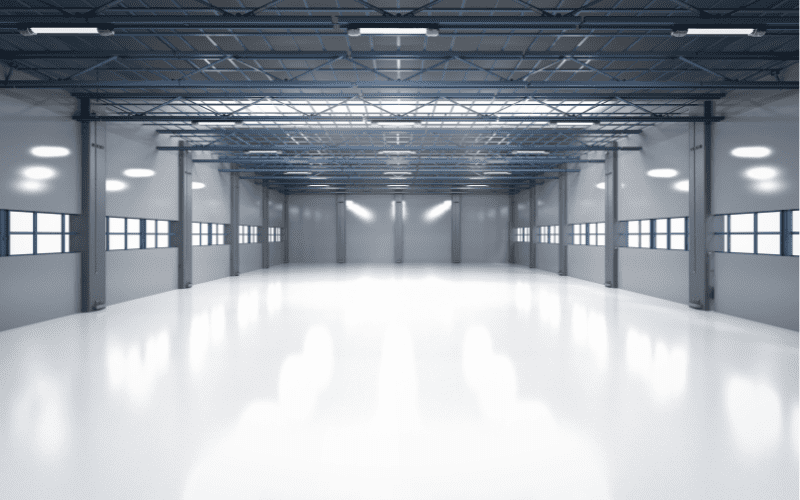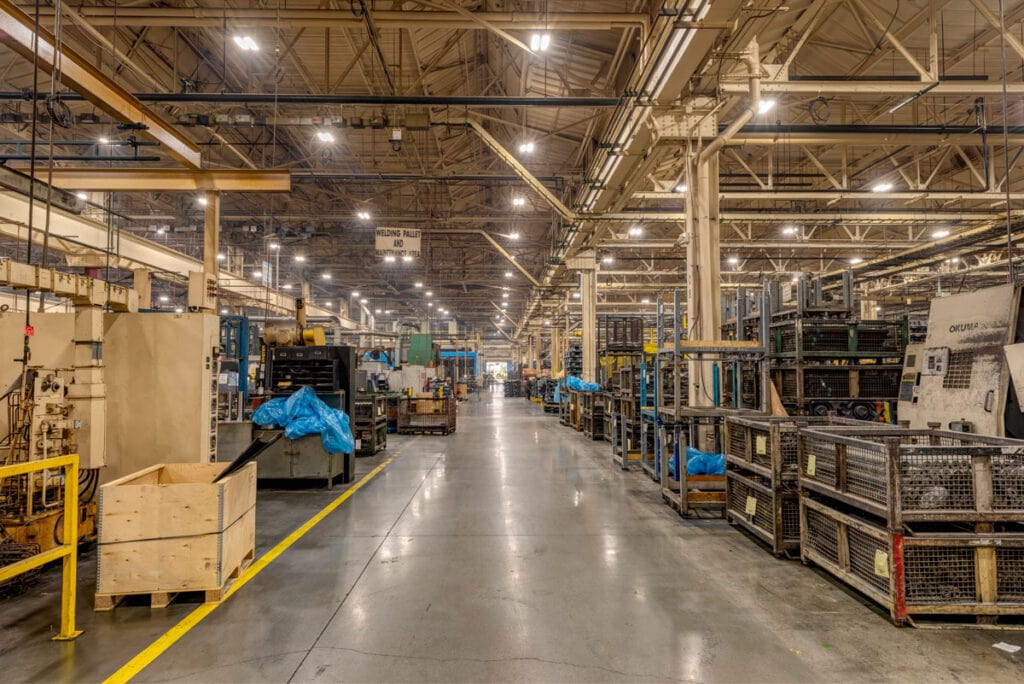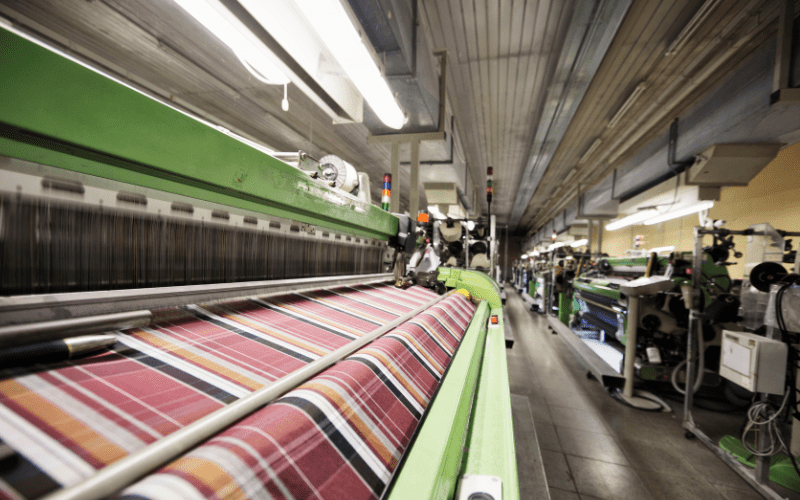However, many people fail to do so because they have no idea how to go about factory lighting. Many wonder about industrial light fixtures’ right brightness, power, type, and quality standards.
Don’t worry. We have got you covered. You need to know everything about factory lighting based on international standards and scientific research.

5 Factors to Consider When Choosing Factory Lighting
1. Industrial Lighting Standard
In factories, warehouses, and workshops, lighting is crucial for effective production and hence governed by different lighting standards. The three most important organizations that monitor industrial lighting are “Occupational Safety and Health Administration(OSHO),” “Illuminating Engineering Society (IES),” and “ American National Standards Institute(ANSI).”
Lighting Units
Illumination is measured using different units such as foot candles (fc), lumens per square feet (lm/sq.ft), and lux. These units quantify how a person perceives lighting. You can learn more about these units in our detailed guide here.
OSHO
OSHO is an American government organization that mostly deals with the private sector. They provide lighting guidelines only for construction work in buildings and shipyards.
| Industry Area | fc and lm/sq.ft | lux |
| Waste areas, dumps, loading, unloading, storage, excavation | 3 | 32 |
| Drilling, mining, underground Tunnel Work | 10 | 110 |
| Workshops, Construction Area | 10 | 110 |
| Offices, Halls, Conference Rooms | 30 | 325 |
IES/ANSI
IES works under the umbrella of ANSI and provides lighting standards for many industries, such as automotive, aerospace, general manufacturing, workshops, etc.
Unlike OSHO, IES gives guidelines to the government, private sector, and self-employed. Instead of specifying the area, IES gives guidelines based on the work performed. So, you have the flexibility to choose the right level of illumination.
| Task / Work | fc and lm/sq.ft | lux |
| Non-work related space, e.g., lobbies, hallways, etc. | 9-18 | 100-200 |
| Manufacturing of large workpieces | 18-46 | 200-500 |
| Manufacturing medium-sized workpieces | 46-93 | 500-1000 |
| Manufacturing of complex workpieces | 93-186 | 1000-2000 |
Note
Values in the standard table may seem a bit low, but mind you; they don’t define the illumination ratings of the industrial lamps. Instead, these values depict the level of illumination observed by the worker.
The lumen rating of typical flood light in a manufacturing industry may be in the order of thousands, but due to immense ceiling heights, in some cases, only a few lumens may reach the ground.
2. Ceiling Height
Factories and industries typically have extraordinarily large ceilings. This is done to accommodate large machines and inventories. Ceiling height becomes a critical factor in lighting design.

So, there is no one size fits all approach, as different industries have different ceiling heights. Taller ceilings require extremely powerful fixtures to keep things running smoothly.
Here’s a good estimate to strive for.
| Ceiling Height (ft) | Lamp Output (Lumens) | Lamp Output (Lux) | Fixture Spacing (ft) |
| 10-20 | 10 K- 20K | 107k-215k | 10-20 |
| 20-30 | 22k-35k | 236k-387k | 15-25 |
| 30-40 | 35-47k | 387k-506k | 19-29 |
| 40 and beyond | 47k + | 506k + | 30-40 |
Ambient Temperature
Ceiling heights can adversely affect the life of lighting lamps. We know that hotter air moves upward while colder air settles down. This temperature difference isn’t apparent in our daily lives but becomes a significant factor in taller ceilings. Surprisingly, the temperature may reach 122 F (50C) surrounding the light fixture. Experts recommend Ingress Protection (IP) ratings of 44 or higher for weatherproof lighting.
IP65 lighting fixtures are best suited for protection against extreme heat and humidity. IP Moreover, they also need the least maintenance.
3. Lighting Requirement
How much lighting you need in a factory depends on the work nature and area. Remember, you must comply with safety standards for better productivity and safety.
A general rule of thumb is that the height of the ceiling determines the space between fixtures vertically ( columns) and horizontally (rows). Moreover, the number of fixtures should be even to avoid unnecessary shadows.
Once the height exceeds 25 ft, it’s better to place fixtures closer to each other. Refer to table 3 for more details on fixture spacing and lumen ratings.
Factory Lighting Scenario
Consider a workshop 80 ft long and 50 ft wide with a ceiling height of 20 ft. You would require three lamps of 22,000 lumens placed vertically at least 20 ft apart. Add another row 20 ft to the side with the same lamp set. The 3X2 pattern will be enough for productive work.
4. Types of Lighting Fixtures
Numerous lighting technologies have been used in factories over the years. Traditionally metal halides, halogens, and fluorescent bulbs were the top choices of owners. But recently, LED lights have dominated the market because of their superior performance. Here are some common fixtures which dominate the industrial lighting scene.
High Bay Lamps
High-bay fixtures are excellent for tall ceilings, typically between 25 ft to 40 ft. They consume higher wattage and, as a result, produce greater illumination. High bay lights have two more subtypes: UFO high bays and high linear bays.

UFO high bays have an “alien saucer ship” shaped fixture design to spread light at a wider beam angle.
Linear High bay lights are long rectangular shape fixtures that distribute lights evenly. You can have them attached to the ceilings or hang them using chains.
Low Bay Lamps
Low bay fixtures are suitable for ceiling heights between 15 and 25 ft. They offer crisp and uniform light distribution at moderate heights. You can also hang low bay lights using chains for better lighting.
Apart from these general types, all the LED factory lights come in different sizes, power, colors, temperatures, and CRI values.
5. Color Temperatures and CRI
Color Rendering Index (CRI) refers to a light source’s ability to reflect the colors correctly. Typically, in factory lighting, a CRI score of 75 to 85 is reasonable. You can go higher if the nature of the work is complex, but it’ll cost higher.
Most factories and warehouses go for cooler color temperatures, 4000K to 6000K, to keep the environment bright and people attentive.

How To Save On Your Energy Bill With The Right Lighting?
Did you know lighting contributes more than 10% of all your energy expenses? The good news is you can reduce this cost by making a few intelligent decisions. Here are some things you can do.
Energy Rebate Programs
The US government incentivizes factory owners willing to install energy-efficient lighting, IT, and HVAC systems. In most cases, the incentives are in the form of cash. You are not only going to save money, but you will also have a profitable long-term solution to your energy needs. It’s a win-win situation. Currently, 3000 utility companies offer rebate programs.
LED High Bay Lights
LEDs have high energy efficiency and economical lighting solutions for industries. They are easy to install and last longer than halogens, halides, and fluorescent lights.
Natural Light
Adding large windows allows you to use natural bright light throughout the day, which can significantly reduce electricity bills.
Installing and Retrofitting Light Fixtures in a Factory
Installation of lighting in a factory is the same as in any other place, with the only difference being size and quantity. If it’s a small to medium size factory, then it’s even possible to do it on your own. Here is how the basic installation works.

Step 1)
Gather the supplies. You’ll need an industry-grade ladder, wire cutter, wire stripper, drill machine, and new, high or low bay light fixtures.
Turn off the main supply to be safe. A new lamp comes with a set of brackets and wires. You can always attach an extra piece if the wire is too short.
Step 2)
In the case of retrofitting, remove the old fixture. This will include the whole frame, starter, ballast (driver), and tube light in case of older lighting technology. You will be left with the AC supply line only. It usually has three wires. Active(Brown or Red), Neutral(Blue or Black), and Ground (Green or Yellow).
Step 3)
Use a drill machine to set up the bracket. A bracket has a screw in the middle that needs to be drilled into a wooden or steel base. Attach the lamp frame to the brackets and join the wires.
Step 4)
Ideally, it’s a good practice to attach the three wires of lighting fixtures with the three wires of the main supply in a similar order. Red to red, black to black, and green to green. However, LEDs don’t get affected even if you join the active and neutral wires oppositely.
Step 5)
Use heat shrinks and wire connectors to secure the connection properly. Switch ON to see whether your new lights work or not.
Benefits of LED lighting in a Factory
LED light fixtures have many benefits, making them popular in modern lighting design.
Cost-Effectiveness
We can divide the cost of any appliance into three parts. The initial investment, maintenance, and operational costs. When it comes to LED, the initial cost is higher, no doubt. But you’ll recover the initial cost and even start saving money in the long run.
LED lamps can run up to 50,000 hours and consume 40% less energy than older technologies. A typical fluorescent light fuses in 15,000 hours and needs replacement.
Numerous Features
LED technology comes in various colors and temperatures. There are also dimmable lights that let you adjust the brightness. Nowadays, intelligent LEDs which have sensors like motion detectors are also available.
Low Maintenance
Older fluorescent lighting often fuses before time or starts to flicker. You either had to change the starter or replace the tube altogether. They are also not weatherproof and prone to external damage. On the other hand, LEDs are known for longevity and lighting controls and don’t need frequent replacement.
LEDs also take an instant to start up and don’t need warming up like metal halides and fluorescent lamps.
Final Thoughts
Hopefully, by going through our detailed guide, you’ll have a stepping stone for an efficient factory, workshop, or warehouse lighting setup. Always be mindful of international lighting and safety standards.
We’ve also discussed ways on how you can save on your electricity bills without having to put in much effort. This will not only improve your profits but open room for more business opportunities.
RC Lighting Is A One-Stop Shop For All Your Factory Lighting
Even with the best lighting designs and plans, you can’t hope to achieve success with substandard luminaires.
Thankfully, RC lighting products are manufactured in a high-tech facility that produces premium quality lighting products. Our industry-leading experts ensure every product meets the highest international standards and deliver quality to your doorstep.
Moreover, you can choose from our vast catalog of products such as architectural, facade, industrial, high bay, low bay, recessed, and spot LED lights.
We serve our customers all around the globe with customized products so that they get the most value for money.
Our 24/7 customer representatives are here to help you make better decisions and guide you through the process. You can also avail FREE evaluation of your project. So what are you waiting for? Get your quote NOW!



